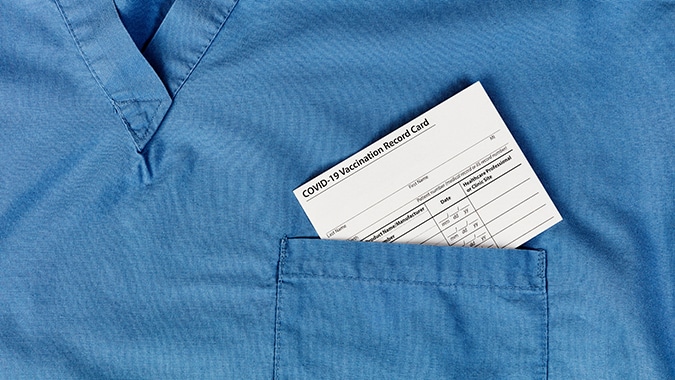
Leveraging a weekly online survey to track how work is evolving due to COVID-19, a random sample of adults aged 18 years and older and employed in the U.S. as of March 1, 2020 was surveyed each week beginning the week of March 16, 2020 through May 11, 2020 to understand how they worked before the pandemic and how things have changed for them since. In total, more than 24,000 workers were surveyed over the course of eight consecutive weeks.
Impact on Workers
For workers currently employed, this new “normal” has many working remotely, forced to adjust to how they get work done. Those required to work remotely responded that the ability to complete tasks and connect with others was severely impacted due to technology issues, lack of necessary equipment to work effectively, and distractions. In fact, one third identified fears of the virus were a barrier to productivity, while about 50% cited technology as a significant obstacle to productivity due to issues with remote access, internet connection and web meetings. As the weeks went on, many workers began to report their work/life balance, ability to complete tasks and connect with others, and personal stress levels were about the same as the week before, rather than consistently declining from week to week. However, despite workers’ ability to adapt to new circumstances, the research uncovered that these markers of productivity do not appear to have returned to pre-pandemic levels.
As with all aspects of day-to-day life during the pandemic, employees indicated a substantial amount of uncertainty — as well as a bit of optimism — regarding their overall outlook. Following an initial decline in employee job confidence, the research shows an increase in employees’ confidence, with nearly 70% of workers now expecting to retain their jobs for at least the next month. Concerns over personal finances appear to be short term as well, with a majority of workers (58%) expecting their finances to return to previous levels in less than six months, even for those not working right now, with very little difference among those who reported job loss or furlough and those who did not. While some experienced changes in pay relative to March 1, those changes have begun to reverse in the weeks following, potentially reflecting more are returning to work.
“The workforce has hit a new ‘normal’ in what it looks like and how it functions, and it is clear that employers and employees adapted quickly to a new way of working,” said Ahu Yildirmaz, co-head of the ADP Research Institute. “This pandemic has significantly changed the world of work, upended employees’ everyday lives, and undoubtedly will have a long-lasting effect on organizations. The rate of the labor market decline is historic, yet employee sentiment has begun to show stabilization. Our research shows that while stress, work/life balance, the ability to connect with others and the ability to complete tasks haven’t returned to pre-pandemic levels, employee outlook appears to be leveling off despite the impact of COVID-19. As the workforce continues to demonstrate resilience by overcoming challenges and adapting to a new way of working, the shifts we’ve seen previously in workforce flexibility will become a necessity.”
Employer Response Matters
The survey reveals worker perception of their employer’s actions today will greatly position the organization competitively for tomorrow and will also impact employee behavior once the pandemic ends. Employees satisfied with their employer’s response to COVID-19 believe their company is putting people first. The promotion of positive thinking, facilitating work from home and encouraging virtual connections are top drivers of employee satisfaction with an employer’s response to the pandemic. As a result, this satisfaction is closely tied to interest in remaining with the employer – with those who are most satisfied likely to indicate they are more interested in staying with their current employer than they were before the COVID-19 outbreak.
COVID-19’s Impact on Employee Outlook
Following are key takeaways from the report:
- U.S. Workers Becoming Comfortable with the New “Normal”: The shift in work and where it is done appears to have reached its new “normal.” In the first few weeks of the crisis, stress levels were high as workers struggled with childcare constraints, fear of the virus, technical issues and trouble completing their tasks. As the weeks progressed, many of these issues became less likely to impact their work. Though elements such as stress, work/life balance, the ability to connect with others and the ability to complete tasks did not get better, they became less likely to get worse each week, possibly signifying workers were becoming more comfortable with the change.
- Financial Concerns Appear to be Short Lived: While 65% of workers indicate COVID-19 has negatively impacted their finances, or will soon, the majority (58%) of workers expect their finances to return to previous levels in the short term, including 60% of those reporting job loss or furlough.
- Increase in Job Confidence and Employer Recovery: Employees reveal they were least confident in their ability to retain their jobs early on, which coincided with the release of record unemployment figures. However, by week eight, there was an increase in confidence, with 68% of workers expecting they would retain their job for at least the next month and one in three (31%) expecting to return to work within the month. This optimism is possibly buoyed by fluctuating stock market, government programs made available and local businesses reopening.
- Long Term Effect of Employer Actions: By week eight, 60% of workers reveal they are satisfied with actions taken by their employer in response to COVID-19, citing increased sanitation procedures, sharing positive messages and limiting customer interactions as the most common company responses according to workers. In fact, more than 60% of those highly satisfied with their employer’s actions believed their company was putting people first. A few companies have made changes to increase PTO, add benefits and support local hospitals or charities.
Please visit ADP Research Institute to view the detailed report, “A Workplace Redefined: Employee Resilience Amid The COVID-19 Pandemic.”

